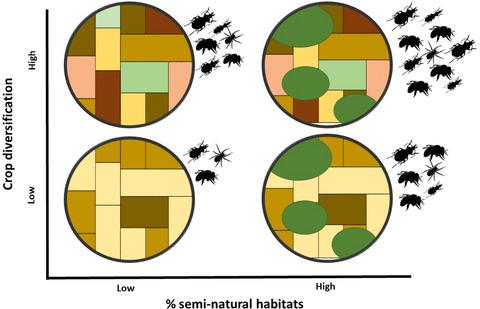当前位置:
X-MOL 学术
›
J. Appl. Ecol.
›
论文详情
Our official English website, www.x-mol.net, welcomes your
feedback! (Note: you will need to create a separate account there.)
Crop diversity benefits carabid and pollinator communities in landscapes with semi‐natural habitats
Journal of Applied Ecology ( IF 5.0 ) Pub Date : 2020-08-12 , DOI: 10.1111/1365-2664.13712 Guillermo Aguilera 1 , Tomas Roslin 1 , Kirsten Miller 1, 2 , Giovanni Tamburini 1, 3 , Klaus Birkhofer 4 , Berta Caballero‐Lopez 5 , Sandra Ann‐Marie Lindström 1, 6, 7 , Erik Öckinger 1 , Maj Rundlöf 6 , Adrien Rusch 8 , Henrik G. Smith 6 , Riccardo Bommarco 1
中文翻译:

在具有半自然栖息地的景观中,作物多样性有益于甲abi和传粉媒介社区
更新日期:2020-08-12
Journal of Applied Ecology ( IF 5.0 ) Pub Date : 2020-08-12 , DOI: 10.1111/1365-2664.13712 Guillermo Aguilera 1 , Tomas Roslin 1 , Kirsten Miller 1, 2 , Giovanni Tamburini 1, 3 , Klaus Birkhofer 4 , Berta Caballero‐Lopez 5 , Sandra Ann‐Marie Lindström 1, 6, 7 , Erik Öckinger 1 , Maj Rundlöf 6 , Adrien Rusch 8 , Henrik G. Smith 6 , Riccardo Bommarco 1
Affiliation

|
- In agricultural landscapes, arthropods provide essential ecosystem services such as biological pest control and pollination. Intensified crop management practices and homogenization of landscapes have led to declines among such organisms. Semi‐natural habitats, associated with high numbers of these organisms, are increasingly lost from agricultural landscapes but diversification by increasing crop diversity has been proposed as a way to reverse observed arthropod declines and thus restore ecosystem services. However, whether or not an increase in the diversity of crop types within a landscape promotes diversity and abundances of pollinating and predaceous arthropods, and how semi‐natural habitats might modify this relationship, are not well understood.
- To test how crop diversity and the proportion of semi‐natural habitats within a landscape are related to the diversity and abundance of beneficial arthropod communities, we collected primary data from seven studies focusing on natural enemies (carabids and spiders) and pollinators (bees and hoverflies) from 154 crop fields in Southern Sweden between 2007 and 2017.
- Crop diversity within a 1‐km radius around each field was positively related to the Shannon diversity index of carabid and pollinator communities in landscapes rich in semi‐natural habitats. Abundances were mainly affected by the proportion of semi‐natural habitats in the landscape, with decreasing carabid and increasing pollinator numbers as the proportion of this habitat type increased. Spiders showed no response to either crop diversity or the proportion of semi‐natural habitats.
- Synthesis and applications. We show that the joint effort of preserving semi‐natural habitats and promoting crop diversity in agricultural landscapes is necessary to enhance communities of natural enemies and pollinators. Our results suggest that increasing the diversity of crop types can contribute to the conservation of service‐providing arthropod communities, particularly if the diversification of crops targets complex landscapes with a high proportion of semi‐natural habitats.
中文翻译:

在具有半自然栖息地的景观中,作物多样性有益于甲abi和传粉媒介社区
- 在农业景观中,节肢动物提供了必要的生态系统服务,例如生物虫害控制和授粉。加强的作物管理做法和景观的同质化导致了这类生物的减少。与大量此类生物相关的半自然生境越来越多地从农业景观中消失,但是已经提出了通过增加作物多样性来实现多样化的方法,以扭转观察到的节肢动物数量下降从而恢复生态系统服务的方式。然而,人们对一个景观中农作物类型多样性的增加是否促进授粉和早节肢节肢动物的多样性和丰富性以及半自然生境如何改变这种关系尚不十分了解。
- 为了测试作物多样性和景观中半自然生境的比例与有益节肢动物群落的多样性和丰富度之间的关系,我们从七项研究中收集了主要数据,这些研究的重点是天敌(甲壳虫和蜘蛛)和传粉媒介(蜜蜂和蚜虫) )在2007年至2017年期间来自瑞典南部的154个农田。
- 每个田地周围1公里半径内的作物多样性与半自然生境丰富的景观中的甲节和传粉媒介群落的Shannon多样性指数呈正相关。丰度主要受景观中半自然生境比例的影响,随着这种生境类型比例的增加,甲abi的数量减少,传粉媒介数量增加。蜘蛛对作物多样性或半自然生境的比例均无反应。
- 综合与应用。我们表明,保护半自然生境和促进农业景观中作物多样性的共同努力对于增强天敌和授粉媒介的群落是必要的。我们的结果表明,增加农作物种类的多样性可以有助于保护提供服务的节肢动物群落,特别是如果农作物的多样化以半自然生境比例较高的复杂景观为目标。











































 京公网安备 11010802027423号
京公网安备 11010802027423号